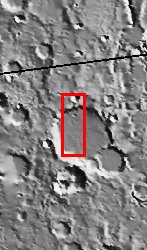
Released 26 May 2003
Just south of the 2 km high main mass of the Medusae Fossae Formation, in a region dissected by channels, lies an unnamed crater that may have been filled by mud. A channel spills into this crater on its eastern side and may have delivered the material that now covers the floor of the crater. The subdued ridges may be wrinkle ridges in a preexisting lava flow that are now covered by a layer of sediment. The cracked surface is evidence for the subsequent deposition of mud.
Image information: VIS instrument. Latitude -6, Longitude 206.7 East (153.3 West). 19 meter/pixel resolution.
Note: this THEMIS visual image has not been radiometrically nor geometrically calibrated for this preliminary release. An empirical correction has been performed to remove instrumental effects. A linear shift has been applied in the cross-track and down-track direction to approximate spacecraft and planetary motion. Fully calibrated and geometrically projected images will be released through the Planetary Data System in accordance with Project policies at a later time.
NASA's Jet Propulsion Laboratory manages the 2001 Mars Odyssey mission for NASA's Office of Space Science, Washington, D.C. The Thermal Emission Imaging System (THEMIS) was developed by Arizona State University, Tempe, in collaboration with Raytheon Santa Barbara Remote Sensing. The THEMIS investigation is led by Dr. Philip Christensen at Arizona State University. Lockheed Martin Astronautics, Denver, is the prime contractor for the Odyssey project, and developed and built the orbiter. Mission operations are conducted jointly from Lockheed Martin and from JPL, a division of the California Institute of Technology in Pasadena.

